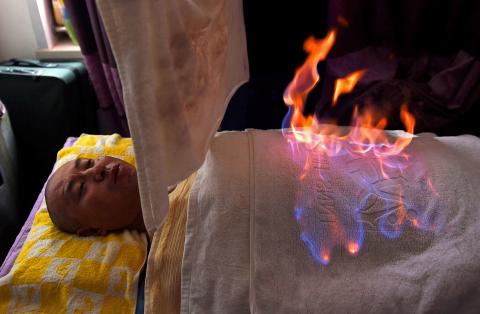A therapist pours alcohol over a patient and sets him alight — for some in China, playing with fire is a treatment for illness.
So-called “fire therapy,” which proponents claim can cure stress, indigestion, infertility and even cancer, has been used for hundreds of years and recently garnered a blaze of attention in Chinese media.
There is no orthodox medical evidence that it is effective, a fact that matters little to one of China’s most prominent fire therapists.

Photo: AFP
“Fire therapy is the fourth revolution in human history... it surpasses both Chinese and Western medicine,” said Zhang Fenghao, who trains students at a dingy apartment in Beijing and charges around 300 yuan (US$48) per hour for treatment.
He applied a herbal paste to a patient’s back, covered it with a towel and poured on water and a 95 percent rubbing alcohol, adding proudly: “Using this method, patients can avoid operations.”
The man, surnamed Qi, lay on his front placidly as Zhang flicked a cigarette lighter, igniting a miniature inferno of orange and blue flames dancing above his spine.

Photo: AFP
“It feels warm, not painful, just warm,” said the 47-year-old, who recently suffered a brain hemorrhage that affected his memory and mobility. “I think it’s effective.”
Many in China cannot afford expensive treatment for chronic ailments and state health insurance is limited, sparking demand for cheaper alternative therapies.
Zhao Jing, 49, who suffers from chronic back pain, had at first been shocked by the idea of the treatment, but added: “After learning everything I don’t have fears anymore.”
The practice is based on Chinese folk beliefs that health depends on maintaining a balance of “hot” and “cold” elements within the body.
“We start a fire on top of the body, which gets rid of cold inside the body,” said Zhang, who claims to have lit blazes on foreign diplomats and senior Chinese officials.
The treatment gained renewed public attention this month when photos of a man having fire applied to his crotch went viral on Chinese social media.
“Sir, how well would you like your meat cooked?” joked one microblogger on China’s Twitter-like Sina Weibo.
BURNING QUESTION
State media have sought to dampen down enthusiasm for fire therapy, running several reports on shady therapists, some without certification and employing only a bucket of water to prevent conflagrations.
“There have been injuries, patients have been burned on their faces and bodies, because of a lack of standards,” said Zhang. “I have taught tens of thousands of students, and we have never seen an accident.”
So far the practice has received little attention from medical journals, but the theory behind it bears some relation to the Chinese medicinal practice of “cupping,” where a flame burns away the oxygen inside a receptacle to create pressure on parts of a patient’s body.
Several long-term studies of that supposed therapy have found little evidence of any effectiveness.
Zhang has received some recognition from publications covering “traditional Chinese medicine,” which is widely available in the country’s hospitals.
The industry is lucrative, producing goods worth 516 billion yuan (US$84 billion) in 2012, according to official statistics.
Looking out from behind his patient’s burning back, Zhang recited a poem.
“A fire dragon has come to earth/a mysterious therapy has its birth,” he said, as flames jumped below his chin.
“Medicine needs a revolution, fire therapy for the world is the solution.”

In the March 9 edition of the Taipei Times a piece by Ninon Godefroy ran with the headine “The quiet, gentle rhythm of Taiwan.” It started with the line “Taiwan is a small, humble place. There is no Eiffel Tower, no pyramids — no singular attraction that draws the world’s attention.” I laughed out loud at that. This was out of no disrespect for the author or the piece, which made some interesting analogies and good points about how both Din Tai Fung’s and Taiwan Semiconductor Manufacturing Co’s (TSMC, 台積電) meticulous attention to detail and quality are not quite up to

April 21 to April 27 Hsieh Er’s (謝娥) political fortunes were rising fast after she got out of jail and joined the Chinese Nationalist Party (KMT) in December 1945. Not only did she hold key positions in various committees, she was elected the only woman on the Taipei City Council and headed to Nanjing in 1946 as the sole Taiwanese female representative to the National Constituent Assembly. With the support of first lady Soong May-ling (宋美齡), she started the Taipei Women’s Association and Taiwan Provincial Women’s Association, where she

It is one of the more remarkable facts of Taiwan history that it was never occupied or claimed by any of the numerous kingdoms of southern China — Han or otherwise — that lay just across the water from it. None of their brilliant ministers ever discovered that Taiwan was a “core interest” of the state whose annexation was “inevitable.” As Paul Kua notes in an excellent monograph laying out how the Portuguese gave Taiwan the name “Formosa,” the first Europeans to express an interest in occupying Taiwan were the Spanish. Tonio Andrade in his seminal work, How Taiwan Became Chinese,

Mongolian influencer Anudari Daarya looks effortlessly glamorous and carefree in her social media posts — but the classically trained pianist’s road to acceptance as a transgender artist has been anything but easy. She is one of a growing number of Mongolian LGBTQ youth challenging stereotypes and fighting for acceptance through media representation in the socially conservative country. LGBTQ Mongolians often hide their identities from their employers and colleagues for fear of discrimination, with a survey by the non-profit LGBT Centre Mongolia showing that only 20 percent of people felt comfortable coming out at work. Daarya, 25, said she has faced discrimination since she